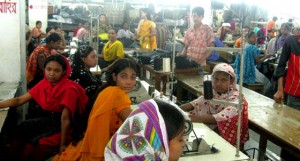The innovative business practice of shared value, whereby profit-driven entities undertake social and environmental missions, naturally prompts contemplation of the possibility of legitimate coexistence of such normally divergent positions. Any such discussion is especially significant today as we celebrate the 45th anniversary of Earth Day, a day set aside by more than 192 countries and 22,000 partners to “activate the environmental movement worldwide, through a combination of education, public policy, and consumer campaigns.”[1]
Virginia Gambrell graduated from Salisbury University on Maryland’s Eastern Shore in 2010, assuming she would end up with a career related to her major in Spanish. Translating documents between English and the romance language of Spanish would have been acceptable for Gambrell, but she was hardly excited at the prospect of becoming a 9-to-5 desk jockey.
“That made me really uncomfortable,” she said.
With World Cup 2014 at its peak, we would be remiss to omit mentioning the ugly business of “the beautiful game.” The truth is that The Federation Internationale de Football Association (FIFA), the international governing body of association football, futsal and beach soccer, has been embroiled in controversy for many years.
Perhaps the greatest complaint about FIFA is its failure at sustainability. When we think of sustainability, most of us consider natural systems, i.e., the environment, natural resources, energy, etc. Often, we ignore the key ingredient of sustainability, namely people or the human factor.
While “certified green labels” used as a mark of sustainable practices are familiar sites on many of the items we purchase, it is important to note that often these labels are used as marketing tools. Theoretically, eco-labels were “designed to elevate products with higher environmental protection standards than the government requires for the status quo.” [1]
Perhaps a major issue with “certified green labels” is that their profits drive approval. Over the past few years, we have witnessed an increased market demand for “green” or “sustainable” products. Any business that promotes a product as green or certifies a product as sustainable potentially stands to make a huge financial gain by maintaining recognition in its industry as a “green” company or by consistently introducing new “sustainable” products into the market. Additionally, increasing demand for green products creates the untended result of lowering standards for the award of green labels so as to fulfill the demand, thereby saturating the market with suspect products. Read More →
For the love of nature!
Though founder Ryan Barry and his team admit profits were not at the forefront of their decision-making process in launching the Halifax, Nova Scotia-based eco-tourism start-up, Great EARTH Expeditions, they can all agree that continuing their efforts is no waste of their time. In fact, according to Ryan, they believe that the best way to get the community to minimize its wasteful impact on the environment is “through education and appreciation for what lays in nature.” So what better alternative exists than to press onward? Live Green Be Green says, “None!”
So, Eco-Tourism?
Yes. Being that eco-tourism is marginally about uniting community and conservation in sustainable travel, Great EARTH Expeditions promises well-planned, exciting and educational adventures through some of Canada’s most beautifully raw countryside. Great EARTH Expeditions‘ guides plunge participants straight into the wonders of nature, from the forest floor to the Canadian coastlines, all the while encouraging in them an elevated appreciation for the surrounding fauna and foliage.
Is all of this an effective approach, you ask? Great EARTH Expeditions believes so.
When you suddenly educate people on things that exist in nature that [people] would not regularly think about in their daily lives, they suddenly look at these precious things and relate it to their own lives and what impact it could have for the future of their children[…] It’s then that people start to begin practices in their daily lives to live greener. Education is powerful! —Ryan Barry, Owner/Operator
Works Apart From Great EARTH Expeditions
Live Green Be Green could not agree more with Ryan’s notion, as it ties into the core value upon which we were founded — the simple sharing of knowledge. Speaking to that a bit further, we delve into the current endeavors Great EARTH Expeditions has outside of its green tourism operations. How can it leverage its voice to influence change?
“Through our social media,” explains Ryan, Great EARTH Expeditions stays “connected with various government organizations […] working to help conserve both fragile landscapes in Nova Scotia and at-risk wildlife species in Canada.” With 18,000+ followers across its range of platforms, Great EARTH Expeditions constantly shares updates on ways to help these governmental efforts. Barry and team hope to one day attain their aspirations of contributing to such efforts through direct involvement in these government initiatives.
I would like to see Canada make well thought out decisions when tapping into our natural resources. It’s no secret that Canada has a vast range of natural resources, but when extracting these resources — whether it be our forests or natural gas — there must be strategic plans in place to lessen the impact on the earth for not only this generation but the next. —Ryan Barry, Owner/Operator
Ryan and his team believe we are beginning to think more along these long-term lines, especially after having witnessed the devastating impacts of improper and irresponsible practices in countries all over the world in recent years. (Think about the Chilean Mining fiasco, the BP Oil Drilling debacle, etc.) The resulting negative impacts of such events have proven to be difficult to correct, at best.
It is well known and understood that the Mother Nature’s climate is not the only one at play. Great EARTH Expeditions is striving towards raising sensitivity to its host nation’s political, environmental and social climate in the work it continues to do. The group at Great EARTH Expeditions believes, as we at Live Green Be Green believe, that every small difference matters. Here’s to a brighter tomorrow.
Has your interest peaked yet?
Be sure to check out Great EARTH Expeditions‘ new webseries, launched earlier this year, to catch some of the amazing footage capturable on their outings!
Here’s Episode 1: Bay of Fundy Pirates, Waterfalls & Sea Caves
March is Women’s History Month, an annual celebration of the successes of women globally, which really needs a dose of reality as it is a major failure in terms of sustainability. It is important to honor trailblazers in the women’s movements who have overcome major challenges and prevailed against adversity and apathy relative to sexism and the lack of economic parity, especially in the United States. However, it is equally important that we remain mindful of the plight of so many people globally, particularly women and children in emerging economies, working in sweatshops under horrendous conditions without receiving a living wage.
In recognition of Women’s History, we choose to recount the tragedy in New York at the Triangle Shirtwaist Factory on March 25, 1911 in which 123 young women and 23 men died in a factory. They were unable to exit the building primarily because of locked exit doors. This fire and loss of life sparked and outrage that prompted factory workers to organize and demand safe working conditions. By 1938, the United States was free of sweatshops.
The outrageous part of this story is that despite this tragedy, sweatshops still exist in other parts of the world, such as Bangladesh. The workers in many of these sweatshops work 12 to 14 hours a day, 7 days a week and only get 1 day off per month. Their wages are significantly less than $1.00 per hour. Just think– these people are making the garments that are exported to the United States for companies such as Wal-Mart, K-Mart and Gap.
What We Can Do
It simply is not enough to commemorate the past successes of women during the month of March or Women’s History Month. We each need to do out part to adopt an awareness of the plight of women and children in emerging nations who are forced to work in sweatshops to provide for their families. We should commit to sustainable living, which first and foremost includes the “human factor.” We are all connected in this world. We have the option of buying food, clothing and other necessities from businesses that endorse principles of “fair trade.”
We owe it to ourselves and the world community to support legislation that bans the import of child labor goods to the United States. With all the information available on the Internet, we encourage you to do a little homework before going out to shop to ensure that you are dealing with businesses who support fair trade. Also, when voting in elections, please consider the candidates’ stand on fair trade legislation before casting your vote.
So, today in honor of the victims of the Triangle Shirtwaist Factory fire, we hope that each of you commit to a life of awareness and sustainability. It is up to each of us to destroy the global sweatshop economy. To do so is to live green, be green.
________________
Resources:
1. http://www.upworthy.com/over-100-years-ago-123-young-women-working-in-a-factory-never-came-home-it-changed-our-country?c=ufb1

Credit: gambling911.com
Now that Super Bowl 2014 is over, it is time to do a sustainability assessment. It is important to do this because the super bowl is the largest annual event held in America, and effort must be undertaken continuously to ensure that all aspects of this event are sustainable in terms of environmental and human impact.
Venue: MetLife Stadium
The NFL’s selection of MetLife Stadium in East Rutherford, New Jersey was appropriate in terms of the facility in and of itself. MetLife Stadium is the home of the New York Giants and the New York Jets. It is deemed “the greenest stadium in the US.” This stadium was constructed on a parking lot between the old Giants stadium and Meadowlands Raceway. The construction of MetLife Stadium had absolutely no impact on greenfield land or natural habitats.[1] MetLife Stadium seats 82,000 people and has 13,000 parking spaces, each costing $150 a piece for Super Bowl 2014.
MetLife Stadium has excellent public transportation links (for normal Giants or Jets game day traffic), and a considerable percentage of football fans use public rail and bus networks to travel to and from the stadium on game days or to attend special events, i.e., concerts.
MetLife Stadium’s 82,000 seats are constructed from 80% recycled cast iron and 20% recycled plastic. There are 2100 HD monitors throughout the facility with a sound system that boasts 2,500 speakers.
MetLife Stadium’s partnership with the Environmental Protection Agency successfully crafted a facility worthy of the designation as one of the most energy-efficient stadiums in the U.S. MetLife Stadium also owns bragging rights to the first certified green restaurant in the world. Some key green facts about MetLife Stadium are:
- Water: Reduced annual water consumption (in comparison to the old Giants stadium) by 25% with savings derived from low flow toilets and waterless urinals, synthetic turf and natural plants.
- Power: Its solar ring has produced 350,000 kilowatts of energy as of February 2013, and it uses 30% less energy by employing Energy Star equipment, automated lighting, efficient windows and biodegradable fuels with reusable fluids in outdoor transformers.
- Construction materials. Made from 80% recycled cast iron and 20% recycled plastic.
- Reduced carbon footprint: Since opening in 2009, MetLife Stadium has avoided 3,176,250 vehicle miles and reduced its carbon footprint by 268,828 metric tons of carbon dioxide.

Credit: social.quintevents.com
Drawbacks and problems
MetLife Stadium is a state-of-the-art facility. Perhaps its biggest drawback in terms of hosting an event of the magnitude of Super Bowl 2014 is its physical location. The NFL dodged a bullet Sunday for the Super Bowl with clear, unseasonably warm weather for the game (temperature at game time was 49 degrees). Bad weather did move in by the end of the game, with rain, sleet, snow and icy roads making travel on Monday a horrific experience for many of the fans. Many people found themselves stuck in the New York area as a large number of flights were cancelled. Hopefully, the reality of climate change in planning huge events will become a major consideration of the NFL.
Secondly and perhaps most important, the location of Super Bowl 2014 in New Jersey with reliance on public transportation to move people proved to be an epic failure. The public rails and buses were ill-equipped to deal with commuter demand. Additionally, the high level of security warranted for an event of this magnitude severely hampered the flow of people into MetLife Stadium, even to the point of people collapsing from exhaustion during excessive wait times at Secaucus Junction.

Super bowls clearly are momentous events in the United States, and as such, the NFL must incorporate sustainability in the planning of this annual event. To date, the NFL has proven that it can deliver an environmentally sustainable product in terms of facility or “stuff,” as witnessed by MetLife Stadium. However, the human components of sustainability must be given equal consideration. In its attempt to host the first mass transit Super Bowl, the NFL had a duty to thoroughly evaluate the human factors and to have contingency plans in place to avoid a transportation debacle. Also, the NFL’s Fan Express pre-ticket coach bus program plan needs to be evaluated and fine tuned to flawlessly control people movement.
In conclusion, with all the hoopla about Super Bowl 2014, proponents of the green movement really would have appreciated it if the NFL had done more to showcase its efforts at sustainability. With 111.5 million viewers tuned in, it would have been nice to see commercials highlighting the NFL’s commitment to commitment to green business and sustainability. This really presented a teachable movement to younger viewers.
Now the NFL will go back to the drawing board and incorporate lessons learned from Super Bowl 2014 in its plans for future super bowls. Hopefully, in its plans, green keywords, such as climate change, environmental impact, transportation, people moving, etc., will be central in the dialogue. To ensure the sustainability of future super bowls is to live green, be green.
_______________________
Resources for this article:
1. http://www.treehugger.com/green-architecture/metlife-stadium-home-years-super-bowl-may-be-greenest-stadium-us.html.
2. http://www.sportingnews.com/nfl/story/2014-02-03/2014-super-bowl-television-ratings-record-most-watched-television-event-of-all-time-seahawks-vs-broncos.
Most viewers of the 2014 State of the Union address, delivered last night by President Barrack Obama, should be praised for having the wherewithal to persevere through such a sleep-inducing collection of strung together sentences — although, among the mind-numbing were a fair share of surprisingly spritely, humorous notes.
Regardless, for those green enthusiasts out there, hoping to learn more about initiatives in the way of sustainability, clean energy, and alternative fuels, there was relatively little mention of such, and with even less value behind it. Far from a laughing matter.
View the enhanced speech on demand –which is by far better than the
live broadcast– if you don’t believe me (tune in around the 15:40 mark).
[youtube http://www.youtube.com/watch?v=arhBRouSmWs&w=560&h=315&start=940]
Unfortunately, the most prolific takeaway for such enthusiasts was a regurgitation of the All-Of-The-Above Energy Strategy, originally introduced several years prior. And let me be clear (pun intended) — by “regurgitation” I don’t mean Mr. Obama repeated himself per se, but I do mean that it was just a simple spewing of what “we” have already accomplished over the past several years’ time.
Some of the facts and statistics used in the accompanying supplemental presentation seem randomly curated and desperately included, almost in some form of a last-ditch attempt to appear arguably progressive. And be careful not to blink when watching the address, you may miss the just-over-four minutes the Pres took to speak to the notions of this All-Of-The-Above plan.
Nonetheless, a brief recap is in order, to point potential non-viewers in the direction of the few notions splayed upon last nights audiences:
- America is closer to energy independence today than we have been in decades. I hope this is self-explanatory.
- Natural gas is being extracted safely. This was an obvious reference to hydraulic fracturing, or fracking, something we have written about in the past and something which environmentalists everywhere denounce.
- Companies are planning to build new plants that use natural gas. President Obama made clear the fact that he wants to promote this via tax and other programs for these manufacturers who indeed increasingly move toward natural gas as a replacement means of production (instead of oil).
- America will continue “strengthening protection of our air, our water, our communities,” and “protect more of our pristine federal lands for future generations” to come. By definition, probably the closest we’ve come thus far to targeting sustainability, but still not compelling. This just seems like some general commentary that could have been used years ago to describe our state, and which seem to be added only because they sound better to the heart than to the mind, once processed.
- We are becoming a global leader in solar — “every four minutes, another American home or business goes solar.” This is a great stat, assuming its factually accurate. Bravo, Mr. President. And his use was impeccable, directly relating solar’s ongoing push to economic job growth by referencing that men (and women) physically installing pieces of such equipment is not outsource-able.
- GOAL: continue to invest in fuels of the future. Check. This should go unsaid — it’s something that would be done regardless of who is in office, be it oval or congressional. Next.
- We can continue to reduce energy we consume. He referenced the new standards for the auto industry, implemented after the bailout, to make vehicles more efficient. Good example, yes, but we have been there and done that, so where else could this be actionable moving forward? Another prospective example would have been beautifully refreshing.
- The US is the leading nation in reducing carbon footprints. Impressive, but how about we explore how we will maintain that role modeling… right?
- We need to legislate new standards on the amount of pollution our power plants are permitted to dump into the air. Air pollution is important, I get it. And as we’ve seen in places like Mexico City and eastern Chinese cities like Beijing, it can quickly get so out of hand as to realizably affect the day-to-day quality of life for area inhabitants. The future can only get worse, if not attended to, so let’s hope something of action can become of this verbiage.
- “The debate is settled: Climate Change Is A Fact!” Again, self explanatory, but a headline-grabbing quote all enthusiasts can be mildly happy about.
Now, that brief recap above contains literally every point I could imaginably pluck from the whole discussion of ecological sustainability, and most of it spoke solely of vague past accomplishments and emptily bottomless comments surrounding the overall direction we are headed. Personally, as someone truly interested in hearing what particulars could lay on the horizon, I was extremely underwhelmed by the President’s words, or complete lack thereof with respect to true governmental policy. This could have been a chance for Mr. Obama to openly target specific goals and initiatives on one of the broadest stages possible, to really put the pressure on Congress to do something about the potential headliners — an opportunity blown.
As one US News and World Report describes fairly well, the State of the Union was predicted to be and then turned out to be unsustainable. The article describes, quite adequately, that sustainability is the focus of making sure our living our lives does not hinder the ability of the generations to come from living theirs. While the State of the Union contained moments wherein the glimmer of hope for the future verged on addressing some social or economic sustainability, environmental sustainability was not allowed to shine in its full brilliance. There was clearly insufficient forethought and future initiatives relayed from the President — no true future plans were outlined for environmental policy.
All of this being said, I must concede that it is not all President Obama’s fault, that the entire State of the Union address seemed monotonous and archaically pointless. In actuality, it is just that, and by inevitability. The State of the Union was originally put into policy as a way for the President of the United States to relay his views on the current status and future agenda of the country to the US Congress. This is especially needless in today’s society of technological advancement, what with all the instantaneous newsfeeds at our constant disposal via push notices to our pocket devices.
Overall, Obama’s address was only half-baked, nearly ignoring future sustainability, clean energy, and alternative fuel plans altogether. But that’s just my opinion.
Got some time to share your opinions? We’d love to hear them!
[polldaddy poll=7755598]
We at Live Green Be Green say, “Time to pass on the palm!”
As a result of palm oil farming, roughly 300 football fields of forest are cleared every hour (WWF). That is roughly 720,000 yards a day! Development of palm oil plantations is among the major leading causes of all deforestation and the leading contributor to diminishing great ape and wildlife populations worldwide. Animals are poached and forests are burned to the ground, just to make way for this unnecessary plant product.
“It is so serious that within the next 10 – 25 years there will be no wild chimpanzees, gorillas or bonobos (let alone Orangutans) if the Palm Oil industry continues on its current forest cutting trajectory.” -Lori Robinson in 1 Sweet Way To Really Help wildlife
We as consumers can end the destruction! We simply need to stop buying products that contain palm oil or palm kernel oil now. Its that simple. The first step in the right direction is to generate universal awareness in terms of which products contain the oil. Palm Oil is commonly used in a wide variety of products. While some products have it listed in the ingredients/ health and nutrition facts, many companies hide it by intentional mislabeling as vegetable oil or leaving it out all together. Everyday known products that contain palm oil include: candy such as Kit Kat, Butterfinger and PayDay, Pringles, Nutella, Johnson and Johnson Bay Oil, Dove Soap, Gillette Shaving creams and Colgate toothpaste, to name a few.
Another reason to avoid palm oil products is that palm oil is relatively unhealthy. In relation to equivalents such as butter, palm oil is significantly higher in saturated fat levels. According to eatingwell.com palm oil is 80% saturated fat with 22 grams of saturated fat contained in just two teaspoons. To put that into perspective, two teaspoons of regular butter only contain 14 grams of saturated fat. Also, research has shown that palmitic acid caused mice to become resistant to the appetite-suppressing hormones leptin and insulin, which in theory could make them eat more.

Products containing palm oil
We here at LGBG ask you to share this post with at least one friend to help spread the word and stop the destruction. Also, please sign the petition at orangutans.org and pledge to save our forests and our wildlife and fight the palm oil industry altogether. http://www.orangutan.org/how-to-help/sign-the-petition
Last but not least, please take a look at the video below for a first an even more in depth look at the destruction cause by Palm Oil.
[youtube=http://www.youtube.com/watch?v=T–15EC72J0&w=560&h=315]
Sources:
- http://www.wwf.org.au/our_work/saving_the_natural_world/forests/palm_oil/fact_sheet/
- http://www.eatingwell.com/blogs/health_blog/the_dangerous_ingredient_you_re_eating_and_don_t_even_know_it
- http://www.earthisland.org/journal/index.php/eij/article/rumble_in_the_jungle1/
- http://africainside.org/2013/10/22/halloween-candy-without-palm-oil/
- http://ran.org/cargill-case-studies-and-videos
One year ago today, the eastern seaboard incurred the wrath of Superstorm Sandy, a massive storm delivering rain, wind and huge storm surges that resulted in hundreds of deaths, extended loss of power to millions of homes, extensive flooding and fire and destruction of homes and businesses up and down the east coast and particularly devastating to New Jersey, Connecticut and New York City.
The reasons for Sandy’s occurrence are still being debated, with climate change deniers holding to their position. While these arguments continue, it is important that we acknowledge changes that are desperately needed to contain or prevent the severe levels of destruction that we experienced with Sandy from recurring, no matter the cause. To that end, the National Resources Defense Council (NRDC) has enumerated post-Sandy priorities for governmental action.
Today we would like to call attention to two of the principal subjects of these post-Sandy priorities, building in flood-prone areas and protection of infrastructure, both of which must be effectively addressed to prevent and/or reduce incidences of loss of life and extreme property destruction during severe storms.
Regarding the issue of building in flood-prone areas, the severe property destruction of water-front or water-accessible residential properties in New York and New Jersey clearly shows us the inherent dangers of living close to large bodies of water, which persistently are subject to huge damaging storm surges during bad weather and accompanying high winds. We know that those living near the water are at such an increased risk of loss of life or property during violent storms, and as such, it is crucial to have plans in place to eliminate the incentives to build or live in flood-prone areas. It appears that even in the face of the destruction of Sandy, many of the shoreline residents have rebuilt or are determined to do so, despite the losses faced with Sandy or the potential future losses from other severe weather occurrences. A probable remedy for this mindset lies in the reform of the National Flood Insurance Program, “including phase-out of subsidized rates and updating of flood-risk maps.” Of course, any such plans should include compensation to individuals currently living in these subject areas. Additionally, property owners who insist on remaining in these areas and who are willing to bear the total cost of insurance for this privilege, must be required by law to rebuild in accordance with stricter resiliency standards. Finally, rules must be adopted to “require states to develop disaster preparedness plans that recognize increased flooding and other disaster risks from our changing climate.”
The second post-Sandy priority subject deals with infrastructure. Sandy’s descent on New Jersey and New York City brought to light the problems with the aging electrical grids, positioning of backup power systems within reach of flood waters and the failing storm water systems in those areas. Also, other jurisdictions on the east coast experienced the failure of sewage systems during extended power outages during the storm, witnessing the spillage of sewage into rivers and streams. Clearly, Sandy warned us of the need to protect critical infrastructure and to make it smarter and resilient to the fury of Mother Nature. We must pay special attention to our energy generation and distribution systems, as well as drinking water and wastewater treatment facilities. Plans for emergency response and public transportation systems are critical to preventing or reducing the loss of life and injury during severe storms and to being able to return to normal function in terms of activities of daily living after severe storms.
The main theme of these subjects of post-Sandy priorities is sustainability. Any effort to address issues of dealing with severe weather must be relative to sustainability. The journey to sustainable lifestyles requires each of us to do our part to protect the environment, to reduce our waste and energy consumption, which taxes our energy generation systems and overall to become stewards of the earth. To do so is to live green, be green.
______________
Sources for this article:
1. http://www.nrdc.org/globalwarming/files/post-sandy-priorities.pdf
2. http://www.baltimoresun.com/news/maryland/howard/ellicott-city/ph-sewage-spill-sandy-20121030,0,4479292.story
Related Articles:
- One Year After Sandy, Communities Rebuilding For Future Storms (newyork.cbslocal.com)
- Hurricane Sandy’s lessons include: Put parks, not houses, on the beach (sciencedaily.com)










